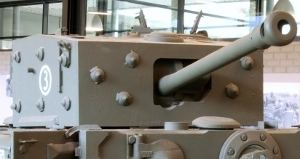Type tank gun Used by British Empire | Place of origin United Kingdom Wars Second World War | |
 | ||
The Ordnance QF 75 mm, abbreviated to OQF 75 mm, was a British tank-gun of the Second World War. It was obtained by boring out the Ordnance QF 6 pounder ("6 pdr") 57-mm anti-tank gun to 75-mm, to give better performance against infantry targets in a similar fashion to the 75mm M3 gun fitted to the American Sherman tank. The QF came from "quick-firing", referring to the use of ammunition with the shell and propellant in a single cartridge. The gun was also sometimes known as ROQF from Royal Ordnance (the manufacturer) Quick-Firing.
Contents
Development
Prior to the introduction of the ROQF 75 mm, British tanks had been equipped with guns such as the QF 2 pounder (40-mm), and then the larger 57mm 6 pounder. These guns were designed to fire armour-piercing shot, small high-velocity solid rounds that were effective against tanks, but did little damage to groups of infantry or soft targets like trucks. Some tanks operating in the infantry support role were given howitzers firing HE shells, such as early models of the Churchill and CS (Close Support) versions of the Matilda II. The decision to equip British tanks with a gun capable of firing HE shells at soft targets was taken by the War Office.
A HE shell for the 6 pounder was in production by the start of the Tunisia Campaign and available in large numbers in the Italian Campaign. However, the round lacked sufficient explosive power. The power of the US 75mm HE round used in the 75mm M3 was found to be markedly superior, and a number of Churchills in operation in Italy had guns scavenged from Sherman tanks and fitted to their turrets to give the Churchill NA75 (NA coming from "North Africa" where the conversions were carried out). Approximately 200 were converted in this way.
Vickers was working on a high velocity 75 mm gun to be fitted to British tanks. This took the cartridge case of the 3 inch 20 cwt anti-aircraft gun mated to the US 75mm AP and HE shell. With a barrel length of 50 calibres, it would have had about twice the muzzle energy of the US 75mm gun. However, the final gun turned out to be too big to fit into the tank that it had been expected to fit.
It was noticed that the US 75mm cartridge was almost the same diameter as the British 6 pounder case. Instead of having to take the American gun to be fitted en masse into modified British tanks, the Royal Ordnance factory modified the 6 pounder design by boring out the barrel and adapting the breech to fire the US round. The resulting gun could then be fitted without redesigned tank mountings. It gained British tanks a good HE shell, but came with an inferior anti-tank round, proving troublesome against a minority of heavily armoured German tanks. In the Battle of Villers-Bocage, Cromwell tanks with the 75mm were outgunned by Tiger tanks of the 101st SS Heavy Tank Battalion.
Though the 75mm had a good HE shell, it was still thought that a more powerful close support weapon was needed and as such the 95mm howitzer was agreed for a limited number of tanks.
Ammunition
The QF 75mm used US ammunition. The shells were "fixed" ammunition, the shell cartridge and projectile being joined together as a single complete round.
Service
The ROQF 75 mm was chiefly used on the Churchill and Cromwell tanks. The weapon was used in Italy and the Normandy invasion (and possibly in Burma against the Japanese) until the end of the war. While the 75 mm was a conversion from the 6-pounder, some units retained a number of 6-pounder-gunned tanks, due to its superior anti-tank firepower over the 75 mm, especially as the 6-pounder could use the even more effective APCR and APDS rounds.
Externally, the gun was nearly identical to the 6-pounder gun. The 14.9 lb (6.76 kg) HE shell fired at 2,050 ft/s (625 m/s) was found to be the best available, and superior to that of the 6-pounder, M7 3 in and 17-pounder, all chiefly anti-tank guns. However, against armour, its AP shell was the worst, penetrating only 68 mm of RHA at 500 yards (460 m) and a 30-degree angle of attack, whereas the AP shells of the others penetrated between 57 mm and 76 mm in Normandy during 1944. The AP shell for the 75 mm gun was a 15 lb (6.8 kg) projectile with a couple of ounces (60 g) of HE filling propelled by a 2 lb (900 g) charge to 2,000 feet per second (610 m/s). In British service, the AP shell was used without its explosive filling, and as such was referred to as "AP Shot M61".
